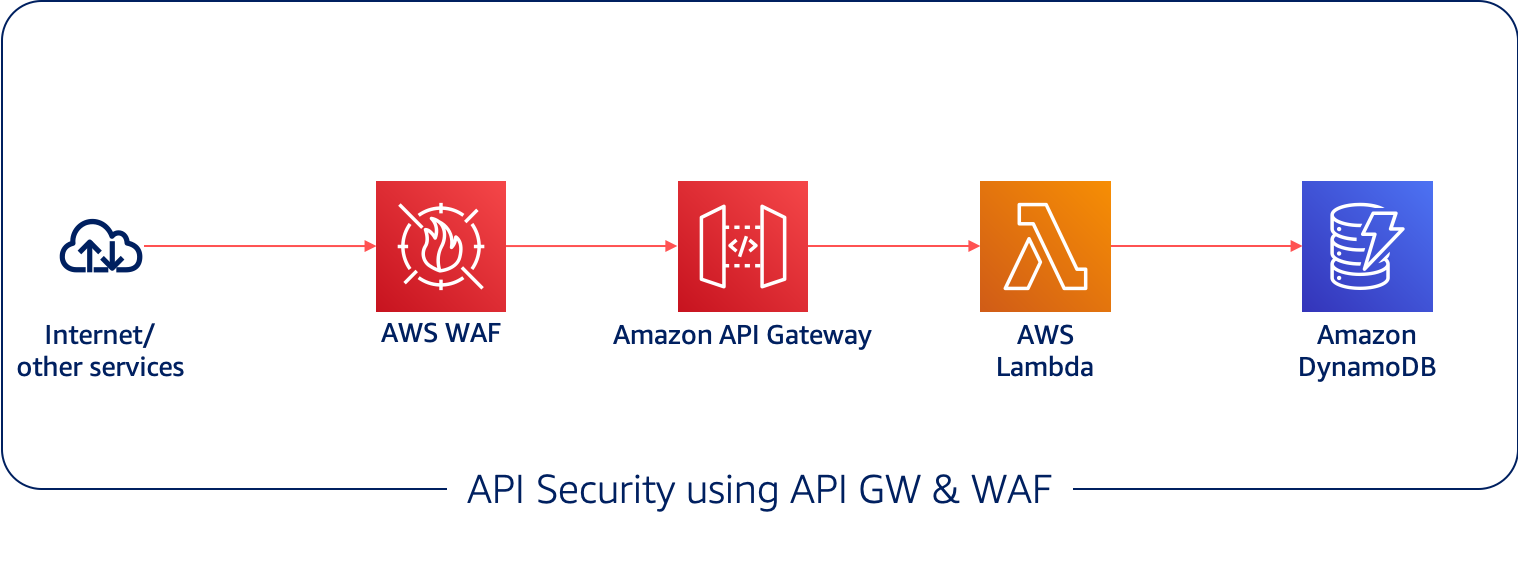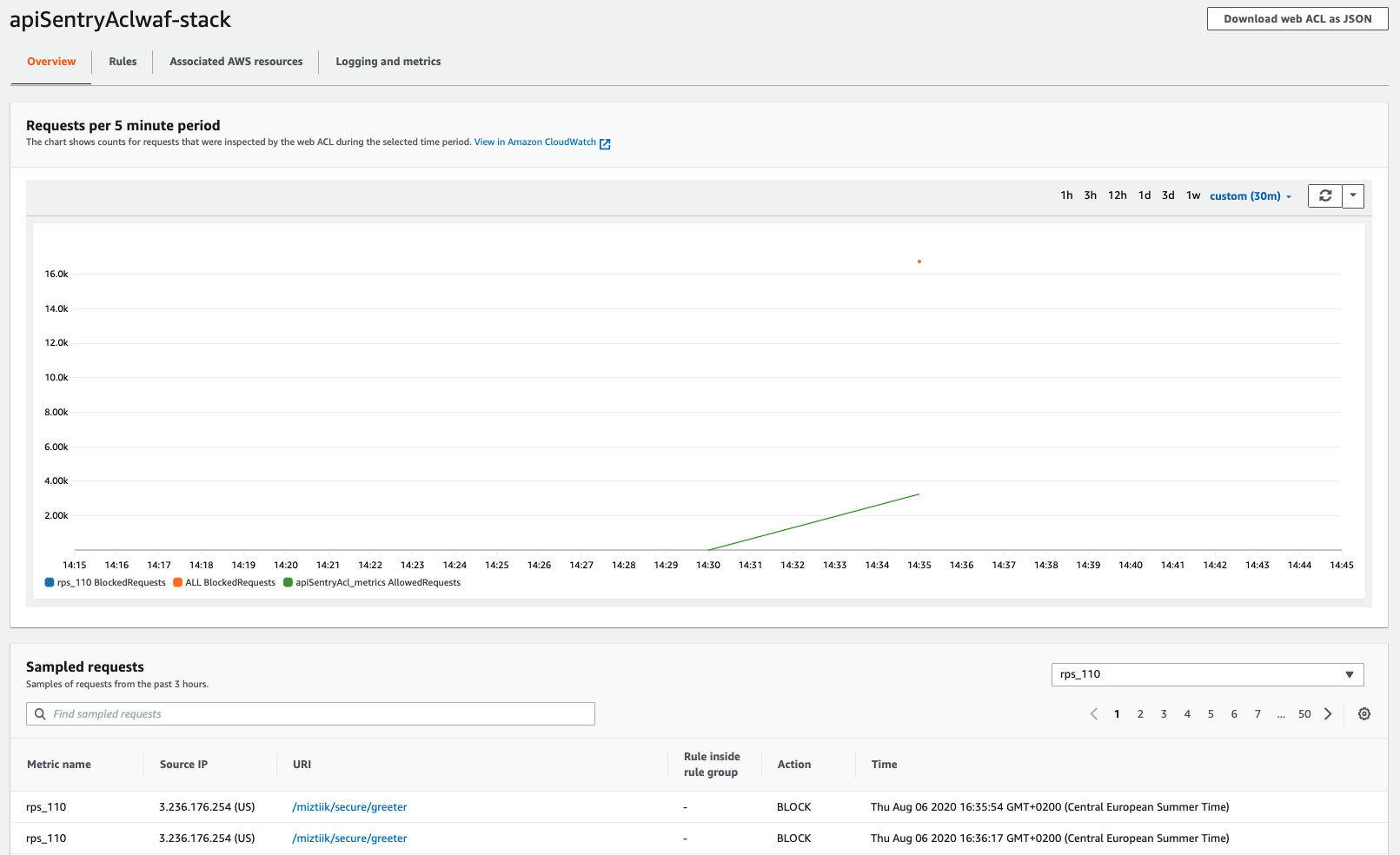Mystique Unicorn App is a containerized microservice made of many APIs. One of the API is open to the public and they encourage their users to build services on top of this API. Althought this API is public, they are looking to protect this API from abuse. For example, they do not want one user to aggressive poll the api and degrade the performance for other users. Another use case they would like to defend against is from bot like requests coming from the same source IPs.
AWS WAF is a web application firewall that helps to protect web applications and APIs from attacks. It enables you to configure a set of rules (called a web access control list (web ACL)) that allow, block, or count web requests based on customizable web security rules and conditions that you define.
Miztiik Corp can add web ACLs and rate-based rules to act on sudden spikes in traffic that might indicate a potential DDoS event. A rate-based rule counts the requests that arrive from any individual address in any five minute period. If the number of requests exceeds the limit(say for example 133 requests per second)defined by you, the rule can trigger an action such as sending you a notification.
In addition to having security at the edge with WAF, Miztiik Corp can also throttles requests to the API at the API Gateway. You can set the limits for individual API stages or methods. When incoming request exceed the request rate and burst limits, API Gateway fails the limit-exceeding requests and returns 429 Too Many Requests error responses to the client. This will ensure the service degradation and alleviates the noisy neighbour problem.
Note: By default, API Gateway limits the steady-state request rate to 10000 requests per second (rps). It limits the burst (that is, the maximum bucket size) to 5000 requests across all APIs within an AWS account.
In this article, we will build the above architecture. using Cloudformation generated using AWS Cloud Development Kit (CDK). The architecture has been designed in a modular way so that we can build them individually and integrate them together. The prerequisites to build this architecture are listed below
-
This demo, instructions, scripts and cloudformation template is designed to be run in
us-east-1. With few modifications you can try it out in other regions as well(Not covered here).- 🛠 AWS CLI Installed & Configured - Get help here
- 🛠 AWS CDK Installed & Configured - Get help here
- 🛠 Python Packages, Change the below commands to suit your OS, the following is written for amzn linux 2
- Python3 -
yum install -y python3 - Python Pip -
yum install -y python-pip - Virtualenv -
pip3 install virtualenv
- Python3 -
-
-
Get the application code
git clone https://github.com/miztiik/secure-api-with-throttling.git cd secure-api-with-throttling
-
-
We will cdk to be installed to make our deployments easier. Lets go ahead and install the necessary components.
# If you DONT have cdk installed npm install -g aws-cdk # Make sure you in root directory python3 -m venv .env source .env/bin/activate pip3 install -r requirements.txt
The very first time you deploy an AWS CDK app into an environment (account/region), you’ll need to install a
bootstrap stack, Otherwise just go ahead and deploy usingcdk deploy.cdk bootstrap cdk ls # Follow on screen promptsYou should see an output of the available stacks,
unthrottled-api secure-throttled-api waf-stack load-generator-vpc-stack miztiik-artillery-load-generator
-
Let us walk through each of the stacks,
-
Stack: unthrottled-api We are going to deploy a simple
greeterapi running as a lambda function. This API is deployed as public endpoint without any throttling or WAF to protect it. The lambda function also does not have any reserved concurrency. This allows the lambda to consume the all the free unused concurrency limits. Although this might be a useful behaviour, in some cases like an DDoS attack, this behaviour is undesirable.When the api is invoked, It returns a simple welcome message along with a timestamp. We should be able to invoke the function from a browser or using an utility like
curl.Initiate the deployment with the following command,
cdk deploy unthrottled-api
Expected output: The
UnthrottledApiUrlcan be found in the outputs section of the stack,{ "message": "Hello Miztiikal World, It is 2050-08-10 21:18:05.1891331 here! How about there?" }We will later use a load testing tool like
artilleryto generate a lot of requests against this url. If you end up overwhelming your API GW, it will respond back with500errors -
Stack: secure-throttled-api
This stack:secure-throttled-api is very much similar to the previous stack. In addition to that, We will also add two configurations to limit the blast radius.
- API throttling in this stack. We will start with a very very conservative limit of
throttling_rate_limitof10andthrottling_burst_limitof100. - The
greeterlambda function will also have itsreserved_concurrent_executionsset to100. This will limit the lambda invocations to a maximum of100per second.
Initiate the deployment with the following command,
cdk deploy secure-throttled-api
Check the
Outputssection of the stack to access theSecureApiUrl - API throttling in this stack. We will start with a very very conservative limit of
-
Stack: secure-throttled-api
This stack:secure-throttled-api is very much similar to the previous stack. We will also add API throttling in this stack. We will start with a very very conservative limit of
throttling_rate_limitof10andthrottling_burst_limitof100.Initiate the deployment with the following command,
cdk deploy secure-throttled-api
Check the
Outputssection of the stack to access theSecureApiUrl -
Stack: waf-stack
To protect our secure api at the edge, we will deploy an Web Application Firewall. As of now, Cloudformation does not support creating rate based rules, so we will use a custom resource to do the same. I have built a very modest rate limit of
133. If any IP address is sending more than133requests per 5 minute period, that IP will be blocked until it falls below the threshold in any 5 minute period.Initiate the deployment with the following command,
cdk deploy waf-stack
-
-
We need a tool/utility to generate 100's or 1000's or requests simulating a real-world use case. We can use the community edition of the
artilleryfor this purpose. We will build a VPC and host an EC2 instance that can run this tool. Additional Activity, Do try this at home: Run artillery as a fargate taskInitiate the deployment with the following command,
cdk deploy load-generator-vpc-stack cdk deploy miztiik-artillery-load-generator
-
Connect to the EC2 instance using Session Manager - Get help here
-
Switch to bash shell
bash -
Install
nodejs# https://docs.aws.amazon.com/sdk-for-javascript/v2/developer-guide/setting-up-node-on-ec2-instance.html curl -o- https://raw.githubusercontent.com/nvm-sh/nvm/v0.34.0/install.sh | bash . ~/.nvm/nvm.sh nvm install node # Confirm Node is installed properly node -e "console.log('Running Node.js ' + process.version)" # Install artilleruy npm install -g artillery # Setup log file location to save artillery test results sudo touch /var/log/miztiik-load-generator-unthrottled.log sudo touch /var/log/miztiik-load-generator-throttled.log sudo chown ssm-user:ssm-user /var/log/miztiik-load-generator-*
-
-
The Outputs section of the
unthrottled-apiandsecure-throttled-apistack has the required information on the urls. Collect themNow we are all almost set to bombard our APIs with requests. As the first step, let us set our API url as environment variables. Ensure you change the values from the appropriate stack
UNTHROTLLED_API_URL="https://3t354sxysj.execute-api.us-east-1.amazonaws.com/miztiik-unthrottled/unsecure/greeter" SECURE_API_URL="https://9r4ftbohse.execute-api.us-east-1.amazonaws.com/miztiik-throttled/secure/greeter"
The below artillery request will generate about 1500 requests, simulating the arrival of 5 users per second and each generating one request. We have also informed artillery to add new users for about 5 minutes(300 seconds). In a real-world scenario, you might want to throw much bigger requests at your workloads. If you are testing and playaround with the services, this can be a good starting point.
artillery quick -d 310 -r 5 -n 1 ${UNTHROTLLED_API_URL} >> /var/log/miztiik-load-generator-unthrottled.log & artillery quick -d 310 -r 5 -n 1 ${SECURE_API_URL} >> /var/log/miztiik-load-generator-throttled.log & # Check the logs for summary tail -20 /var/log/miztiik-load-generator-unthrottled.log tail -20 /var/log/miztiik-load-generator-throttled.log
Expected Output,
$ curl ${SECURE_API_URL} {"message":"Forbidden"} # If you want to try verbose curl $ curl -v ${SECURE_API_URL} # truncated output ... < HTTP/2 403 < content-type: application/json < content-length: 23 < x-amzn-requestid: b5b76376-29f1-4e9a-99e6-5e19ebe7bb82 < x-amzn-errortype: ForbiddenException < x-cache: Error from cloudfront < via: 1.1 5eb5e19c1a78889d10ff8f1551ed2aa.cloudfront.net (CloudFront) < x-amz-cf-pop: IAD89-C1 < x-amz-cf-id: MngW-1YE6-LXbV6d5K21jOtSYTkVdVd_IUDMAvk4HWUaYLVtxeRQA== ... # truncated output
You can notice that after throwing more
133requests at the WAF+API GW, You should be able to see the public IP address of EC2 instances being blocked by WAF. Dont forget to update the _web-acl-id of your waf# Get the list of IP addresses blocked by rate-based rules ]$ aws wafv2 get-rate-based-statement-managed-keys \ --scope REGIONAL \ --region us-east-1 \ --web-acl-name apiSentryAcl-waf-stack \ --web-acl-id b4d65ec-44cd-a8ec-b147136faa52 \ --rule-name imit_rps_to_110 { "ManagedKeysIPV4": { "IPAddressVersion": "IPV4", "Addresses": [ "3.236.176.254/32" ] }, "ManagedKeysIPV6": { "IPAddressVersion": "IPV6", "Addresses": [] } }
Here is a snapshot of the WAF dashboard showing the
allowedandblockedrequests. As the requests reached the threshold in a5minute period, all the remaning requests were blocked.Here we have shown how to use WAF to protect your APIs from http floods. This also has the effect of reduced cost, as there are no backend lambda invocations. Even if you dont have a WAF, the API throttling will kick-in and result in HTTP
429errorsI have done these tests for different durations[
3,6,12seconds] for 100 users, each generating 51 requests. This comes to about15300,30600, and61200requests. Here are the results,Artillery_Config_Summary Unthrottled_Api Throttled_Api Unthrottled_Api Throttled_Api Unthrottled_Api Throttled_Api artillery_duration 3 3 6 6 12 12 artillery_arrival_rate 100 100 100 100 100 100 artillery_req_per_user 51 51 51 51 51 51 Artillery Summary Report Scenarios launched 300 300 600 600 1200 1200 Scenarios completed 300 300 600 600 1200 1200 Requests completed 15300 15300 30600 30600 61200 61200 Mean response/sec 75.35 258.36 139.84 347.65 168.88 301.27 Response time (msec) min 14 3.4 13.4 4.1 14.9 3.8 max 10418.6 10850.3 10425.6 10756.5 12208 10407.4 median 75 111.9 69.9 123.6 432.3 137.5 p95 9121.6 238.1 9064.4 261.7 9410.8 306.9 p99 10036.8 168 10041 945.6 10306.2 926.8 Scenario counts 100% 300 300 600 600 1200 1200 Codes 200 14576 575 29247 437 58424 758 403 226 21809 49208 429 14499 8354 11228 500 6 502 724 1353 2776 You can observe here that, With throttling & WAF, we were able to block a significant amount of spam traffic, maintain the
minresponse times under increased load and also serve a p95 in about300msAdditional Learnings: You can check the logs in cloudwatch for more information or increase the logging level of the lambda functions by changing the environment variable from
INFOtoDEBUG -
-
If you want to destroy all the resources created by the stack, Execute the below command to delete the stack, or you can delete the stack from console as well
- Resources created during Deploying The Application
- Delete CloudWatch Lambda LogGroups
- Any other custom resources, you have created for this demo
# Delete from cdk cdk destroy # Follow any on-screen prompts # Delete the CF Stack, If you used cloudformation to deploy the stack. aws cloudformation delete-stack \ --stack-name "MiztiikAutomationStack" \ --region "${AWS_REGION}"
This is not an exhaustive list, please carry out other necessary steps as maybe applicable to your needs.
This repository to teaches how to secure your api with WAF & API GW Throttling to new developers, Solution Architects & Ops Engineers in AWS. Based on that knowledge these Udemy course #1, course #2 helps you build complete architecture in AWS.
Thank you for your interest in contributing to our project. Whether it's a bug report, new feature, correction, or additional documentation or solutions, we greatly value feedback and contributions from our community. Start here

Level: 300


